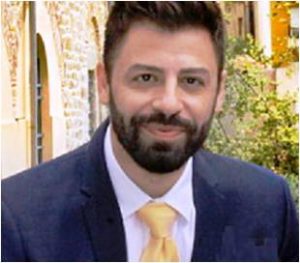2016 New Investigator: Panagiotis Vorkas


Nominee:
Nominated By:
Supporting Comments:
What made you choose a career in bioanalysis? (100 word limit)
As I approached the completion of my bachelor’s degree, I realised that bioanalysis held the key to biological experimental observation. Therefore, during my thesis and internship, I pursued training in modern analytical technologies. During my master’s, I developed an interest in metabolomics and holistic analytical technologies. I found the concept of metabolomics fascinating, due to the ability to accurately delineate the corresponding biological phenotype. Consequently, I joined a world recognised group in the field, as a PhD student, where I worked in developing a workflow to cover the wide physicochemical properties of metabolites. I subsequently applied this workflow in disease.
Describe the main highlights of your bioanalytical work, and its importance to the bioanalytical community (200 word limit) (i.e. a new analytical technique developed, new method developed which reduced cost/increased efficiency of an assay, diagnostic tool developed)
During my PhD, I developed a metabolic profiling workflow utilising two untargeted UPLC–MS methods which, when combined, expanded metabolome coverage. The rigorous optimization of these methods and implementation of new and much needed concepts in quality control, suggestions in post-acquisition artefact exclusion, structural assignment of a wide range of metabolites and development of an experimental setup to achieve this resulted in several key publications (e.g. Vorkas et al, Anal Chem,2015). Additionally, due to my interest in tissue analysis – essential for efficient elucidation of the target pathology – I also focused in optimisation of tissue extraction for metabolic profiling and biological pathway mapping.
Application of the developed pipeline in different manifestations of cardiovascular disease, demonstrated its superior ability to expand metabolite coverage and most importantly their efficiency – as untargeted methods – to detect previously unreported but biologically important molecules (Vorkas et al, J Proteome Res, 2015) and elucidate dysregulated pathways in disease (Vorkas et al, Int J Cardiol, 2015; Eur J Vasc Endovasc Surg, 2016).
I am currently working on validating biomarkers and biological pathways discovered as being significant to the studied cardiovascular disease manifestations. Additionally, I maintain my effort towards further improving metabolome coverage by assessing additional methods and techniques.
What is the impact of your work beyond your home laboratory? (I.e. an example of your works implementation in an external setting) (150 word limit)
The analytical pipeline I have developed has been adopted by my laboratory and is being universally applied. Additionally, although my work has been published recently (2015–16), it became obvious – from literature (Nzoughet et al,Metabolomics,2015) and personal communications – that several laboratories are implementing the workflow described in my papers. My (workflow) application on atherogenesis (J Proteome Res, 2015) has been characterised as being of “major importance” by McGrath and Young (2015), with praising comments.
My publications have collectively been cited 199 times and I have been invited to present my work, with emphasis on the comprehensive metabolome coverage concept at international seminars addressing the challenges of small molecule analysis and profiling.
Apart from the objective of increasing metabolome coverage, I have structurally assigned hundreds of metabolites and compiled and published a database which is being used internally and is being adopted as part of an international network of phenome centres.
Describe the most difficult challenge you have encountered in the laboratory and how you overcame it (200 word limit)
Metabolite structure assignment is considered the ‘bottleneck’ of untargeted metabolic profiling. Due to the untargeted manner of acquiring UPLC–MS data, the analysts tend to face tremendous challenges in identifying the detected metabolites. I was no exception! Firstly, it is usually the case that the only information available is the accurate mass of the molecule. This is generally due to negligence in acquiring important UPLC-tandem-MS data during analysis that could aid in metabolite structure elucidation. I had therefore implemented these experiments in my published workflow (Vorkas et al, Anal Chem, 2015) and provided several metabolite structures in order to aid the community with this challenge. Additionally, as several metabolite classes (such as lipids) have characteristic (tandem-MS) fragmentation patterns, I have collected information from my analyses and literature, and created guides that could provide this information in a concise way. I am looking forward to sharing this guide with the scientific community and a paper is currently under preparation delineating all the useful information I have collected through several years of work in metabolite identification. Finally, the skills acquired are considered an asset by my research group and I am currently leading the metabolite identification courses (internal and external) conducted by my department.
Describe your role in bioanalytical communities/groups (i.e. bioanalytical focus groups, inter-disciplinary groups) (200 word limit)
I have been an associate member of the Royal Society of Chemistry (RSC) and a member of its analytical division, for several years. I am also a member of the Chromatographic Society and the British Mass Spectrometry Society. Additionally, since 2011, I am an active member of the Bioanalysis Network, an interdisciplinary team aiming to develop synergy in the wider European area, and disseminate research work and know how in the field of bioanalysis. Specifically, I am a member of the organising committee of the “4th Workshop on Holistic Analytical Methods for System Biology Studies”, organised by the Bioanalysis Network.
I consistently participate in international conferences in order to disseminate research work and to network. Since my PhD graduation (2013) I have presented more than ten lectures regarding metabolite structure elucidation in departmental (internal) and external courses. I am also a consultant for the National Phenome Centre assisting with metabolite identification.
I hold a special interest in science outreach and bringing knowledge to the general public. As a member of the STEMNET scheme and the departmental outreach committee I have delivered activities involving audiences enrolled in establishments from nurseries to high schools.
Please list up to five of your publications in the field of bioanalysis (posters and presentations accepted):
- Vorkas PA, Isaac G, Anwar MA, Davies AH, Want EJ, Nicholson JK, Holmes E. Untargeted UPLC-MS profiling pipeline to expand tissue metabolome coverage: application to cardiovascular disease. Anal Chem. 87(8), 4184–4193 (2015).
- Vorkas PA, Shalhoub J, Isaac G, Want EJ, Nicholson JK, Holmes E, Davies AH. Metabolic phenotyping of atherosclerotic plaques reveals latent associations between free cholesterol and ceramide metabolism in atherogenesis. J Proteome Res. 14(3),1389–1399 (2015).
- Vorkas PA, Isaac G, Holmgren A, Want EJ, Shockcor JP, Holmes E, Henein MY. Perturbations in fatty acid metabolism and apoptosis are manifested in calcific coronary artery disease: An exploratory lipidomic study. Int J Cardiol.197,192–199 (2015).
- Vorkas PA, Shalhoub J, Lewis MR, Spagou K, Want EJ, Nicholson JK, Davies AH, Holmes E. Metabolic Phenotypes of Carotid Atherosclerotic Plaques Relate to Stroke Risk – An Exploratory Study. Eur J Vasc Endovasc Surg. In press (2016).
- Anwar MA, Vorkas PA, Li JV, Shalhoub J, Want EJ, Davies AH, Holmes E. Optimization of metabolite extraction of human vein tissue for ultra performance liquid chromatography-mass spectrometry and nuclear magnetic resonance-based untargeted metabolic profiling. Analyst. 140(22),7586–7597 (2015).
Please select one publication from above that best highlights your career to date in the field of bioanalysis and provide an explanation for your choice (100 word limit)
- Vorkas PA, et al. Anal Chem. 87(8), 4184–4193 (2015).
This paper describes my efforts to implement analytical pipelines that aim towards wide metabolome coverage in metabolic profiling practice. At the same time it depicts the value of metabolite identification, highlighting the importance of quality control, utilising untargeted methods and their ability to detect previously unknown biologically important metabolites. The significance of this workflow has been well demonstrated in applications by us and others. Importantly, by utilising pathway mapping tools, the developed pipeline provides the framework for further identifying pathways not sufficiently represented, in order to enforce their representation by implementing additional methods.
Find out more about this year’s New Investigator Award, the prize, the judging panel and the rest of our nominees.


